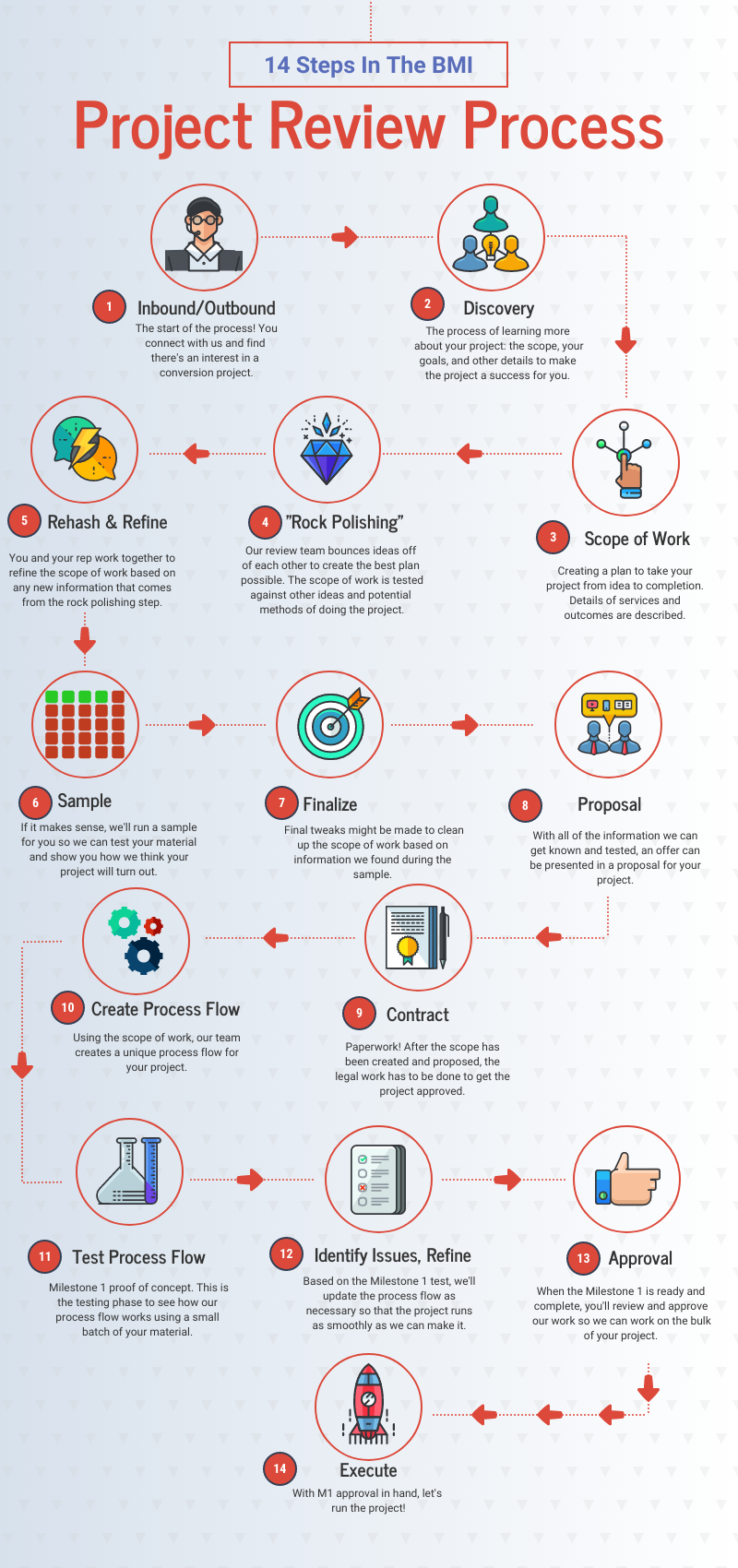You’re going to get a peek under the hood. There’s nothing “secret” about the info here, but we’re giving you a glimpse into the internal process we use to take a digital conversion project from an idea to a delivered solution.
If you’ve worked with us before or are currently working with one of our reps, you’ve probably experienced a few of the steps we describe. If you’re just starting your research and are deciding who you want to partner with, this’ll give you a look into how we do business.
Our Project Review Process From 10,000 Feet
The BMI Project Review Process is our 14-step method of taking your project from idea to reality. Fourteen steps sounds like a lot, but most of it is internal and you won’t have to get involved in the nitty-gritty stuff. The process also isn’t set in stone: although most of our projects do go through every step, it’s normal for other project so skip steps or go out of order. That’s just the nature of the business and we’re flexible!
Our sales team is usually the first contact you’ll have with BMI. Once you get in touch with us you’ll go through an initial project discussion with a sales rep to create a general scope of work and find out if the project seems to be a good fit for the both of us.
Your project then goes through our “Project Review” process, a meeting where a group of our operations staff get together to review sales opportunities. We offer ideas and suggestions to the sales rep so that we accept projects that match our strengths and to ensure that we’re able to deliver the services our customers need. This is a completely internal meeting, meaning you won’t have to be involved during this part – it’s almost like a secondary sales process because our sales reps are “selling” your project to our operations team!
Once your project has been reviewed, refined, and approved internally, the next major step is starting the project with what we call the Milestone 1 Proof of Concept, a test phase to ensure the scope of work we’ve created will actually work.
Who’s involved in the project review?
The core team for our project review includes members from software, operations, sales, and management. This cross-section gives us the ability to bounce ideas around and have diverse opinions so that we create the best possible solution for the projects we’re evaluating.
We also bring in other employees if the project requires specialized knowledge or skills; examples of these ad hoc members include our coders, scanner-operators, and data entry employees.sk.
Why do we do this?
Short answer:
To make sure we accept projects that we’ll be able to execute successfully for our clients.
Longer answer:
Back in the day, we didn’t have a project review process and jobs would just come in based on our sales team working with the client. Our salespeople know their stuff, but as technology improved and projects became more complicated, a gap started to grow between what was being sold and what our production staff could actually do. To re-align everything we started doing these project reviews, and we’ve seen a big jump in successful projects and less rework.
And for you, our (future) customer, we want to make sure you get what you need, not just what you want. We bring a lot of project knowledge and experience to the table, and sometimes our customers have ideas that just won’t play out well down the road; it’s our job to make sure we offer guidance and recommendations to create positive outcomes. You may have a particular position or strategy in mind when you think about a digital solution; our staff can help you focus on the end goal and offer alternate methods to achieve that goal and provide additional value to you.
The 14-Step BMI Project Review Process
The infographic below lays out all 14 steps in our review process. There’s additional information about each step below the infographic if you’re interested in learning more.

Step 1: Inbound/Outbound Project Initiation
The two ways we’ll start our relationship together are either you get in touch with us, or we initiate contact with you. That’s it! If you get in touch with us it might be at a trade show or giving us a call based on a referral from a friend of yours. Or we may call you out of the blue or send you an email about projects we can help with. If you’re really curious about our outbound efforts, we have an entire article about it that you’ll love!
Whatever way we make the connection, this is always the first step in the sales process. If we get connected in some way, we’ll put you in touch with one of our reps we think is the best fit and they’ll take you to the next step, Discovery.
Step 2: Discovery
Once we’ve gotten in touch with each other and a digital conversion project’s been mentioned, the discovery step begins. We’ll ask you questions about the size of the project, what type of material it consists of, what the overall goal is, how you want the digital files organized, what your timeline is, and so on.
This is really the part where we feel each other out and decide if we want to move on to the next step and really get grinding on details. Some projects just aren’t for us for various reasons, or you may decide that based on what we’re able to offer isn’t right for you. That’s okay because we’re not a one-size-fits-all company and sometimes we’re not the best choice.
Step 3: Initial Scope of Work
The initial scope of work (SOW) is what our sales rep brings to the table to kick off the Project Review meeting. The SOW covers what you and they spoke about, what the goal of your project is, which services we’ll be providing, and how much it’ll cost.
The goal for our sales team is to come in with a great SOW that covers all the requirements you asked for, touches on any bumps and roadblocks we may encounter during the project, and lays out the path from start to finish once we decide to partner up on your project.
Step 4: “Rock Polishing”
Assuming that the SOW wasn’t perfect (it’s hard to be perfect), there’ll be some refinement to the initial scope. Let’s call this “rock polishing” because the sales rep will get bounced around and feel like they’re in a cement truck tumbler, but at the end of the review the objective is to have a shiny diamond of a project!
This part is where the Project Review team fires questions at the sales rep, asking about “why this?” or “why not that,?”, covering anything from scanning method to indexing, image delivery format, and pricing. This step of the Review is tough for any sales person, regardless of experience or tenure: the questions come hard, fast, and many, all with the goal of creating a project that’s both good for our company and good for you.

Step 5: Refine the Scope of Work
If your sales rep comes back to you with additional questions about your project, take this as a positive! It means that our team found some holes in the plan and we’re catching them before we start your project, preventing issues down the road once the project is underway.
We try to limit the back and forth with you about your project as much as we can, but if you find yourself providing more information than you thought you’d need to, we want you to know it’s because we’re crafting a plan for you that ends well, even if it takes a little longer up front.
Step 6: Sample
After the initial SOW and (maybe) some further discussion to firm up details about your project, you might be interested in having us run a sample test for you. Samples normally include a few units from your overall project, such as a roll or two of microfilm, a few sheets of microfiche, a box of paper records, and so on.
What we normally like to do is use the current scope of work and run your material through a sample process flow, and then check out the results. We can take a look at the quality of the digital images we create, the indexing layout, any issues that popped up during the sample, and so on. Once we have this information we can move to the next step and finalize the scope of work and get you our best offer based on what we know.
Step 7: Evaluation and Finalization
At this point we should have plenty of information for our sales rep to put together the finalized scope of work and our offer. If there was a sample, we may do a little more investigation if anything odd came up, but if the sample confirmed our assumptions about the project then we wouldn’t have to revisit anything. Once our review team and sales person are all on board, we’ll approve the project based on understood scope and pricing and move on!
Once we get to this point the project review ends. Occasionally a project will get approved but then come back through the review because a customer finds some new information or material that has to be added, or the length of time between approval and the actual project moving forward is so long (we’ve seen projects finally show up after being approved over a year prior). If that’s the case, we may have a quick recap to make sure we’re all still on the same page.
Step 8: Proposal
Once the Project Review team has batted around your project and come up with all the brilliant ideas we can to make it a slam-dunk project, your sales rep will put together a proposal and send it over to you. This’ll include some general assumptions about your project based on what we know so far, the scope of work to describe what services we’ll actually be providing, and associated cost items.
The proposal may be revised and refined, but it’s usually pretty solid once we’ve run through the Project Review process. After you’ve reviewed the proposal and agree with the scope and pricing, you’ll move on to the contracting!

Step 9: Contract
Who doesn’t love reading contracts?! Well, probably everybody. Contracts aren’t exactly exciting, and with all the legalese used in them they can cause headaches a-plenty. But they’re still necessary to get your project off the ground and as long as everyone involved is cordial and collaborative, they can be finished up almost painlessly.
After you’ve reviewed, refined, and revised the proposal our rep sent to you, it’s time to get that scope of work and pricing into a contract! We love using our standard agreement but we also know that you probably have your own contract that has to be used. Either way is fine – the real key is to get the contracting started early, even possibly before the scope of work and proposal is finalized. If you’ve gotten to the point where you know you want to work with us, it’s good to get ahead of the game and start the contract review so that the legal and admin stuff doesn’t hold up actually starting the project for too long.
Instead of going into more detail here, check out our article about contracts for more of our opinions and ideas. Yes, we actually wrote an article about contracts.
Step 10: Creating the Project Process Flow
We revere our project process flows: they’re the frame that holds our projects together and guides our team from start to finish. Jobs have gotten more complicated as technology continues to advance and expand, and we use our process flows to keep us on track and focused.
Once the scope of work is approved and the project has gotten the green light from both you and BMI, our Project Architect will create the initial process flow. Our Project Architect is our primary process flow creator and has the experience of crafting hundreds (probably thousands) of projects from scratch, so she takes the first swing at building any new process flow.
Step 11: Testing the Process Flow
Once your process flow is created, we test it by running a small batch of your material so we can test the steps we put in place and see how they work out. If you have a microfilm scanning project, we’ll test a couple of rolls; if you have a paper scanning project, we’ll test a box or two. The critical thing is to try and test a good cross-section of your overall project so we can see how different parts of the whole may turn out.
Step 12: Identify and Resolve Issues, Refine Process Flow
It’s rare when we don’t find an issue with a project. We just don’t know what we don’t know before we get started on a project, so the Milestone is helpful to surfacing issues or potential issues early.
If we find a problem with your material or a step in the scope of work isn’t possible due to some unforeseen circumstance, we’ll flag the problem and get in touch with you to review it. Sometimes our team can solve an issue through their creativity, but sometimes the problem requires discussion with you to see how we can move forward.
Once the issue’s been identified and discussed with you, our Project Architect will rework the process flow based on the new information and we’ll re-test the process flow.
Step 13: Approval
When your test batch has successfully gone through the process flow, your sales rep will reach out to review the Milestone to show you what we’ve put together and ask for your approval.
This is a critical step for our project team: once we have approval we’ll be ready to go full steam ahead on the bulk of your project, so if you need any changes or have concerns about the final product, now’s the time to let us know!
If all’s well and you’re happy with the Milestone 1 (the quality of the digital images, the indexing/organization of your files, and so on), give us the thumbs up and we can get started on your project.
Step 14: Execution – Run The Project
Blast off time! Now that we have your approval we’re ready to move on the rest of your project. We’re built for large-volume jobs, so we always like to get your M11 approval and start on the main portion of your material.
Once we have approval for the M1, our Project Architect turns over your project to one of our Project Managers. Our project managers are tasked with:
- using the approved process flow to run the project
- tweak the process flow to allow for any requested or required changes in the project
- communicate with and update our sales rep who brought the job in
- communicate with other people on an as-needed basis (they may get in touch with you with questions or updates)

Why Go Through All This Work?
Because we’re stubborn. It’s important that we get your project right the first time, both for our and your sake. We don’t want to redo it because of a lapse in expectations, or a mistake in the scope of work. Let’s take small steps and make sure we’re doing the right thing throughout the project so that you’re happy at the end and you can immediately use what we deliver.
We’re stubborn. In a good way.
Next Steps
Reach out to us today! Click the “Get Your Quote” button below, fill out the form, and we’ll quickly reply to you to discuss your project.
Further Reading
If you’re still not sure about us, read some other posts we’ve put together so you know we’re serious about what we do:
“Why Should I Hire A Scanning ‘Expert?’” covers the logistics of a digital scanning project so that you have the knowledge to make a decision to either scan your material internally or work with a third party to handle the conversion.
“Choosing A Partner For Your Secure Scanning Project” lays out our recommendations for you to consider as you research potential scanning companies. If you’re dealing with sensitive data, you’ve got to be extra cautious.
“Quality Assurance & Digital Conversion” describes some methods to have your digital images and data checked once they’re digitized. This is a backend process that’s important but often overlooked.

